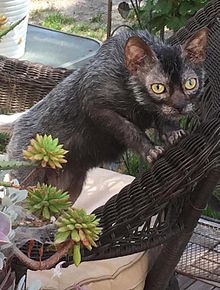
The Bengal cat is a breed of hybrid cat created from crossing of an Asian leopard cat, with domestic cats, especially the spotted Egyptian Mau. It is then usually bred with a breed that demonstrates a friendlier personality, because after breeding a domesticated cat with a wildcat, its friendly personality may not manifest in the kitten. The breed's name derives from the leopard cat's taxonomic name.
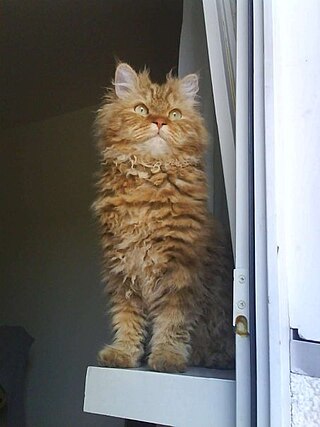
The Selkirk Rex is a breed of cat with highly curled hair.

The Sphynx cat also known as the Canadian Sphynx, is a breed of cat known for its lack of fur. Hairlessness in cats is a naturally occurring genetic mutation, and the Sphynx was developed through selective breeding of these animals, starting in the 1960s.

The Munchkin is a breed of cat characterized by its very short legs, which are caused by genetic mutation. Compared to many other cat breeds, it is a relatively new breed, documented since 1940s and officially recognized in 1991. The Munchkin is considered to be the original breed of dwarf cat.

The American Bobtail is an uncommon breed of domestic cat which was developed in the late 1960s. It is most notable for its stubby "bobbed" tail about one-third to one-half the length of a normal cat's tail. This is the result of a cat body type genetic mutation affecting the tail development, similar to that of a Manx cat. The breed is not related to other short-tailed breeds, such as the Cymric cat, or the Japanese Bobtail or Kurilian Bobtail, despite the similar name and physical type—the breeding programs are entirely unrelated, and the genetic mutation causing the bobbed tail are known to be different, as the mutation causing the American Bobtail's short tail is dominant; comparatively, the Japanese Bobtail, for example, has a tail mutation that is recessive.

Cat coat genetics determine the coloration, pattern, length, and texture of feline fur. The variations among cat coats are physical properties and should not be confused with cat breeds. A cat may display the coat of a certain breed without actually being that breed. For example, a Neva Masquerade could wear point coloration, the stereotypical coat of a Siamese.

The Singapura is the smallest breed of cat, noted for its large eyes and ears, ticked coat, and blunt tail. Reportedly established from three "drain cats" imported from Singapore in the 1970s, it was later revealed that the cats were originally sent to Singapore from the United States before being exported back to the US. Investigations by the Cat Fanciers' Association (CFA) concluded that no wrongdoing had occurred and the Singapura kept its status as a natural breed.
A crossbreed is an organism with purebred parents of two different breeds, varieties, or populations. Crossbreeding, sometimes called "designer crossbreeding", is the process of breeding such an organism. While crossbreeding is used to maintain health and viability of organisms, irresponsible crossbreeding can also produce organisms of inferior quality or dilute a purebred gene pool to the point of extinction of a given breed of organism.
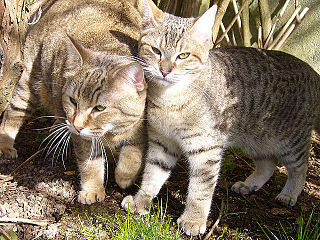
The Pixie-bob is a breed of domestic cat claimed to be the progeny of naturally occurring bobcat hybrids. However, DNA testing has failed to detect bobcat marker genes, and Pixie-bobs are considered wholly domestic for the purposes of ownership, cat fancy registration, and import and export. They were, however, selected and bred to look like American bobcats.

The Donskoy cat, also known as Don Sphynx or Russian Hairless, is a hairless cat breed of Russian origin. It is not related to the better-known Sphynx cat whose characteristic hairlessness is caused by a recessive mutation in the keratin 71 gene. The Donskoy's hairlessness, on the other hand, is caused by a dominant mutation.
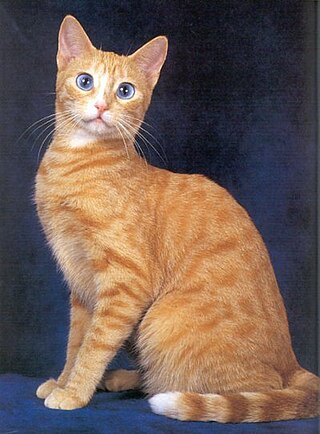
Ojos Azules was a breed of shorthaired domestic cat with unusual blue or odd eyes caused by a dominant blue eye (DBE) genetic mutation. The breed came in all coat colors; however, only particolors, colorpoints, and intermediate colors with a characteristic white tail tip were permitted. The breed also had a semi-longhaired coat variety, the Ojos Azules Longhair. Due to the lethal side effects of the Ojos Azules gene, breeders stopped working with this blue eye mutation.
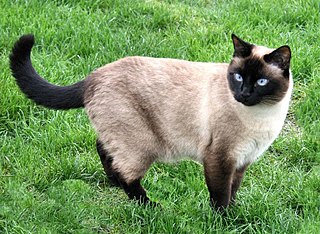
Point coloration is animal coat coloration with a pale body and relatively darker extremities, i.e. the face, ears, feet, tail, and scrotum. It is most recognized as the coloration of Siamese and related breeds of cat, but can be found in dogs, rabbits, rats, sheep, guinea pigs and horses as well.
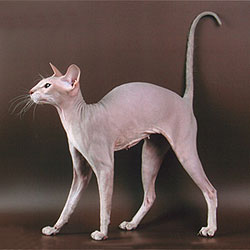
The Peterbald is a hairless cat breed of Russian origin. It was created in St. Petersburg in 1994 from an experimental cross of a Don Sphynx and an Oriental Shorthair. They have an Oriental build with a dominant hair-losing gene. The breed was accepted for Championship status in 2009.
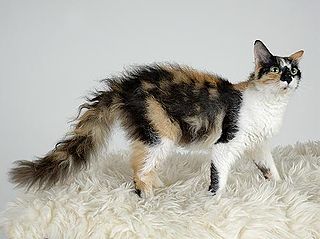
The LaPerm is a breed of cat. A LaPerm's fur is curly, with the tightest curls being on the throat and on the base of the ears. LaPerms come in many colors and patterns. LaPerms generally have a very affectionate personality.
Out-crossing or out-breeding is the technique of crossing between different breeds. This is the practice of introducing distantly related genetic material into a breeding line, thereby increasing genetic diversity.

A dwarf cat is a domestic cat with dwarfism due to rare genetic mutations causing a disproportionate feline body and significant health problems. Unlike undersized cats of normal proportions, dwarf cats suffer from the genetic mutations osteochondrodysplasia and achondroplasia. These genetic disorders of bone and cartilage are typically manifested as abnormal bone shape, poor growth or lack of growth, bowing of the limbs to the side – front legs are more likely to be affected, and spinal malformations.

An Oriental bicolour is any cat of Oriental type, either long-haired or short-haired and in any pattern including colourpoint, which has white areas on its coat caused by the white spotting gene. In most cat fancier and breeder organisations, Oriental bicolours do not constitute a standardised breed, but a coat pattern variant of the breed of their foundation stock. One breed registry is an exception, the UK-based Governing Council of the Cat Fancy (GCCF), which has defined them as a separate breed named Oriental Bicolour (capitalised).

Traditional Persian is one of several names for a group of cats that are considered to be essentially the original breed of Persian cat, before the variety was selectively bred to have extreme features. Other everyday usage names are: Doll Face Persian, Classic Persian, Old Fashioned Persian, Long-nosed Persian, Old-style Longhair, Traditional Longhair and Original Longhair.
